That's how most foreign designs were, but the US favored turrets in tank killers, hence the M10 (and later, the M36).Also, the tank destroyers didn't have turrets. Their guns were fixed, which meant the entire vehicle had to be swiveled to bring to bear on a moving target.
75th anniversary of D-Day...
- Thread starter crimsonaudio
- Start date
- Status
- Not open for further replies.
The most commonly-made German armored vehicle of the war was the StuG-III, a medium velocity 75mm cannon mounted on a Pzkw-III (!) chassis.Thanks. Looks like the US had turreted versions while other countries went with the turret-less route.
The Germans made numerous other tank destroyers in typical German fashion, over-engineered, finicky machines that worked well in a lab, but less well in the field. The Germans made too many different vehicles manufactured in too few numbers (StuG-IV, Elephant, Nashorn, Hetzer, Jagdpanther, Jagdtiger). The Jagdtiger II had a mammoth 128mm cannon (today's tanks only have a 120mm cannon). Fortunately, the Germans only produced 88 models.
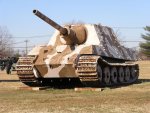
The Soviets also favored turretless TDs: SU-85
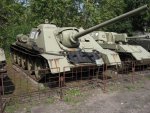
and SU-100

being their most common. (The Russian writing on the side says, "On to Berlin!")
The Army (and, I suppose the Marine Corps) analyze terrain using a mnemonic device OCOKA.To provide a frame of reference as to why go straight through the forest, with its forbidding terrain and defensive fortifications, the "reason," or, more probably, "alibi" was that it was the most direct route to the Roer or "Rur" River (not the Ruhr) dams. The fear was that the dams would be scuttled and the plain below flooded, slowing the advance into the heart of Germany. IIRC, that happened anyway. Apparently, it never occurred to the Allied Command to wheel to the south and seal it off. That move would also probably aborted Hitlers Bulge offensive, which kicked off through the Ardennes from the forest. Maybe Tidewater will chime in with more detail...
Observation and fields of fire
Cover and Concealment
Obstacles
Key terrain
Avenues of approach.
A forest offers limited observation and fields of fire. You can only see so far in a forest.
A forest gives dismounted infantry cover and concealment. It does, however, present a problem when artillery fires into the forest using high angle shelling. Artillery at the time had a few different fuzes: point detonating (PD; the round explodes when it hits something hard, like the ground or a tree), time fuzes (the round is set to explode after a certain amount of time; very difficult to estimate the flight time accurately), and proximity fuzes (the round explodes when it gets close to something; a very expensive fuze, so used in limited amounts). Dismounted infantry in a forest is concealed from machine gun fire (which is good), but artillery firing at dismounted infantry in a forest can get the arty rounds to explode 10 meters up in the trees, which showers the infantry with shrapnel, which is very, very bad, even for infantry in foxholes. Jim Dunnigan wrote in the Book How to Make War, "In World War II, artillery did most of the killing and infantry did most of the dying.")
Forest presents obstacles to vehicular traffic, although maybe not as much as you might imagine for heavy vehicles like tanks and halftracks, which can run over bigger trees than you think. In a forest, vehicles will be more limited to avenues of approach, even while dismounted infantry can get off into the woods away from the roads, at least until they get casualties and need ammo resupply.
Key terrain in a forest would probably be crossroads, bridges.
As for going around Huertgen, the front extended from the North Sea to the Swiss border, so there was no "getting around" the Wehrmacht by late September 1944. Somebody was going to have to execute a frontal assault somewhere. If you avoid the trees, then you are looking at the open rolling countryside, with excellent observation and fields of fire, no cover or concealment, few obstacles and certain easily identified avenues of approach. Open terrain presents a whole different series of problems. If you asked the Canadian troops on Walcheren Island if they would like a forest to fight in (as opposed to flat open farmland on Walcheren), they would probably accept gladly.
The Huertgen Forest fight did cause Hitler some concern (and the Germans did have to commit the 116th Panzer Division (a division earmarked for Wacht-am-Rhein) to prevent a breakthrough in Huertgen, but the grinding of that Allied offensive to a halt before December relieved Hitler of that concern.
Last edited:
The first ones, the M-3 and M-6 did not have turrets...That's how most foreign designs were, but the US favored turrets in tank killers, hence the M10 (and later, the M36).
Are you saying that you think that going through the Hürtgen was the better choice? I've not read that viewpoint anywhere. At least, to the south, we would have had the benefit of our air superiority, which scarcely mattered in the Hürtgen...The Army (and, I suppose the Marine Corps) analyze terrain using a mnemonic device OCOKA.
Observation and fields of fire
Cover and Concealment
Obstacles
Key terrain
Avenues of approach.
A forest offers limited observation and fields of fire. You can only see so far in a forest.
A forest gives dismounted infantry cover and concealment. It does, however, present a problem when artillery fires into the forest using high angle shelling. Artillery at the time had a few different fuzes: point detonating (PD; the round explodes when it hits something hard, like the ground or a tree), time fuzes (the round is set to explode after a certain amount of time; very difficult to estimate the flight time accurately), and proximity fuzes (the round explodes when it gets close to something; a very expensive fuze, so used in limited amounts). Dismounted infantry in a forest is concealed from machine gun fire (which is good), but artillery firing at dismounted infantry in a forest can get the arty rounds to explode 10 meters up in the trees, which showers the infantry with shrapnel, which is very, very bad, even for infantry in foxholes. Jim Dunnigan wrote in the Book How to Make War, "In World War II, artillery did most of the killing and infantry did most of the dying.")
Forest presents obstacles to vehicular traffic, although maybe not as much as you might imagine for heavy vehicles like tanks and halftracks, which can run over bigger trees than you think. In a forest, vehicles will be more limited to avenues of approach, even while dismounted infantry can get off into the woods away from the roads, at least until they get casualties and need ammo resupply.
Key terrain in a forest would probably be crossroads, bridges.
As for going around Huertgen, the front extended from the North Sea to the Swiss border, so there was no "getting around" the Wehrmacht by late September 1944. Somebody was going to have to execute a frontal assault somewhere. If you avoid the trees, then you are looking at the open rolling countryside, with excellent observation and fields of fire, no cover or concealment, few obstacles and certain easily identified avenues of approach. Open terrain presents a whole different series of problems. If you asked the Canadian troops on Walcheren Island if they would like a forest to fight in (as opposed to flat open farmland on Walcheren), they would probably accept gladly.
The Huertgen Forest fight did cause Hitler some concern (and the Germans did have to commit the 116th Panzer Division (a division earmarked for Wacht-am-Rhein) to prevent a breakthrough in Huertgen, but the grinding of that Allied offensive to a halt before December relieved Hitler of that concern.
Not really, just that the Germans knew what the Americans were up to (trying to seize the dam) and packed troops into the Huertgen to prevent it. The resulting carnage got blamed on the forest when most of the difficulty came from attacking where the Germans predicted the attack would come. The German troop density in the Ardennes at that moment was probably 10% of that at the Huertgen Forest.Are you saying that you think that going through the Hürtgen was the better choice? I've not read that viewpoint anywhere.
I can tell you from personal experience as a light infantryman that woods were much better for attacking than open fields. The furthest a German infantryman can see in the Huertgen was say, 150 meters. In an open field, a Mauser or a MG42 can engage targets out to 1,000 meters. That is the deadly ground that must be crossed. The more deadly ground, the more casualties.
Good point, except when the weather was poor, which in November it frequently was. In crap weather, air superiority was not very useful to Allied infantry because it wasn't flying or, if the fighter-bombers did fly, they could not distinguish between friend and foe on the ground.At least, to the south, we would have had the benefit of our air superiority, which scarcely mattered in the Hürtgen...
Last edited:
November 5, 1944: In the northwest, Operation Infatuate continues as British 155th Infantry Brigade lands at Flushing on Walcheren Island and British 4th Special Services Brigade lands at Westkapelle (also on Walcheren Island). Royal Navy battleship Warspite and monitors Erebus and Roberts bombard German positions and Canadian 1st Army attacks around the causeway from South Beveland to Walcheren Island. The British 2nd Army finishes clearing sector south of the Maas while US 3rd Army regroups and prepares for new attacks. US 7th Army captures Baccarat, Bertrichamps, and La Bourgonce.
Nearby, at the Hurtgen Forest, the 112th remains hard pressed to hold its positions outside Schmidt as the overwhelming German forces push hard. Division HQ sends orders to the 28th Infantry Division to move tanks down the Kall trail. However, no staff officer had gone forward to assess the situation in person, and in fact the "trail" is solid mud blocked by felled trees and disabled tanks. The attack leads only to more heavy loss of life, but the 28th keeps attempting to push forward, as ordered.
RAF Bomber Command sends 25 aircraft on special operations with supplies and agents for Resistance forces overnight.
Over Germany, US 8th Air Force attacks Gelsenkirchcen with 256 bombers, Hamm, Koblenz, and other targets with 60 bombers, and Vienna, Graz, Gussing, Kapfenburg, and other targets. meanwhile, RAF Bomber Command sends 242 aircraft to attack Homberg during the day escorted by 145 fighters, 288 aircraft to attack Oberhausen, 49 aircraft to attack Berlin, and 20 aircraft to attack Cologne, Karlsruhe, and Mulheim (all overnight). RAF Bomber Command also sends a second air raid on Solingen, Germany, where 1,300 houses and 16 industrial buildings are destroyed; 1,600 buildings are damaged; 1,882 are killed.
In Italy, British troops capture Ravenna, Italy, cutting the rail line to Bologna, while British 8th Army attacks around Collina, Grisignano, and Forli.
Pictured: British troops of 41 Commando advance through Westkapelle towards the tower on Walcheren island as part of Operation Infatuate, November 5, 1944.; The Kall trail, needed as a supply route, early November, 1944.; RAF Avro Lancaster bomber on a bombing mission over Solingen, Germany, November 5, 1944.; Cpl. Carlton Chapman, a machine-gunner in an M-4 tank, attached to a Motor Transport unit near Nancy, France. 761st Mt. Bn. November 5, 1944.
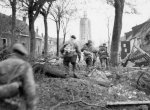
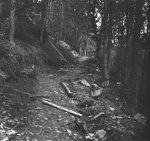
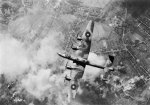
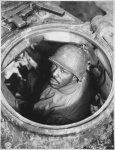
Nearby, at the Hurtgen Forest, the 112th remains hard pressed to hold its positions outside Schmidt as the overwhelming German forces push hard. Division HQ sends orders to the 28th Infantry Division to move tanks down the Kall trail. However, no staff officer had gone forward to assess the situation in person, and in fact the "trail" is solid mud blocked by felled trees and disabled tanks. The attack leads only to more heavy loss of life, but the 28th keeps attempting to push forward, as ordered.
RAF Bomber Command sends 25 aircraft on special operations with supplies and agents for Resistance forces overnight.
Over Germany, US 8th Air Force attacks Gelsenkirchcen with 256 bombers, Hamm, Koblenz, and other targets with 60 bombers, and Vienna, Graz, Gussing, Kapfenburg, and other targets. meanwhile, RAF Bomber Command sends 242 aircraft to attack Homberg during the day escorted by 145 fighters, 288 aircraft to attack Oberhausen, 49 aircraft to attack Berlin, and 20 aircraft to attack Cologne, Karlsruhe, and Mulheim (all overnight). RAF Bomber Command also sends a second air raid on Solingen, Germany, where 1,300 houses and 16 industrial buildings are destroyed; 1,600 buildings are damaged; 1,882 are killed.
In Italy, British troops capture Ravenna, Italy, cutting the rail line to Bologna, while British 8th Army attacks around Collina, Grisignano, and Forli.
Pictured: British troops of 41 Commando advance through Westkapelle towards the tower on Walcheren island as part of Operation Infatuate, November 5, 1944.; The Kall trail, needed as a supply route, early November, 1944.; RAF Avro Lancaster bomber on a bombing mission over Solingen, Germany, November 5, 1944.; Cpl. Carlton Chapman, a machine-gunner in an M-4 tank, attached to a Motor Transport unit near Nancy, France. 761st Mt. Bn. November 5, 1944.




Had to look that one up as well.The first ones, the M-3 and M-6 did not have turrets...
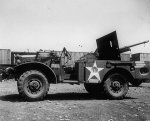
That does not strike me as a good idea. Mounting a very small AT gun on an unarmored truck, makes the vehicle and crew very vulnerable.With the design standardized in February 1942, 5,380 GMC 37 mm M6 GMC were built between April and October, 1942, at a cost of $4,265 per unit.
Last edited:
Here is the tricky bit about the Huertgen Forest.November 5, 1944: ... The Kall trail, needed as a supply route, early November, 1944.;
View attachment 4801
Ever since basically Napoleon, the key to success in the tactical attack has been integrating all branches. In Napoleons day, an attack that integrated infantry, artillery and cavalry had a much greater chance of success than an attack by infantry alone. The same idea applied to World War II tactical attacks. An attack that integrated infantry, armor, artillery (and, when possible close air support), had a much greater chance of succeeding than an attack by infantry alone. The defense, on the other hand, depended on disintegrating the attacking force, making them attack as infantry alone, then armor alone, etc. Just like today's football, making your opponent one-dimensional makes defeating him easier. If all you can do is run the ball and there is no threat whatsoever of passing, you are easily defeated.
Now, look at the terrain in the Huertgen. Most of those trees a Sherman could drive right over. The Krall Trail (driving from the photographer along the trail in the center of the photo) could be followed by a deuce and a half, as crappy as that road was. A truck or tank trying to go from left to right or especially from right to left (i.e. uphill), on the other hand, is not going to make it. The slope is the problem. Thus, a tank-infantry team that runs into stiff resistance advancing along that trail is naturally going to try and flank the German position, but the fighter-bombers could not see what they were strafing or bombing and the tanks could not handle that slope, so not that infantry-armor-artillery-air team is now just an infantry-artillery team. If the Germans have overhead cover on their fighting positions, then the U.S. forces are reduced to just infantry. Infantry can do the job alone, but it is going to take lots of casualties and they need a massive numerical superiority, which, given the density of German troops, they could not achieve. Hence, very slow progress and a chewed-up infantry division (28ID).
Here is why the Aachen-Huertgen sector was such a bloodbath:

This is the situation map that was closest to the first week of November. (this one is from 27 Oct 44)
Facing the XIX and VII Corps (five infantry divisions, two armored divisions) you had six German infantry divisions, a panzergrenadier division, three panzer divisions and a panzer brigade. Even if those divisions were relatively depleted, that makes the Aachen-Huertgen sector the most densely packed sector on the German Western Front. The odd against the Americans were long (7 divisions versus 10.5 divisions). Long odds.
Last edited:
maybe they were looking for "speed, speed, speed" (in my best ua coaches voice)! Sorry, couldn't help myself.Had to look that one up as well.
View attachment 4805
That does not strike me as a good idea. Mounting a very small AT gun on an unarmored truck, makes the vehicle and crew very vulnerable.
You've given the reasons wheeling south would have been worse. What would you have done?Here is the tricky bit about the Huertgen Forest.
Ever since basically Napoleon, the key to success in the tactical attack has been integrating all branches. In Napoleons day, an attack that integrated infantry, artillery and cavalry had a much greater chance of success than an attack by infantry alone. The same idea applied to World War II tactical attacks. An attack that integrated infantry, armor, artillery (and, when possible close air support), had a much greater chance of succeeding than an attack by infantry alone. The defense, on the other hand, depended on disintegrating the attacking force, making them attack as infantry alone, then armor alone, etc. Just like today's football, making your opponent one-dimensional makes defeating him easier. If all you can do is run the ball and there is no threat whatsoever of passing, you are easily defeated.
Now, look at the terrain in the Huertgen. Most of those trees a Sherman could drive right over. The Krall Trail (driving from the photographer along the trail in the center of the photo) could be followed by a deuce and a half, as crappy as that road was. A truck or tank trying to go from left to right or especially from right to left (i.e. uphill), on the other hand, is not going to make it. The slope is the problem. Thus, a tank-infantry team that runs into stiff resistance advancing along that trail is naturally going to try and flank the German position, but the fighter-bombers could not see what they were strafing or bombing and the tanks could not handle that slope, so not that infantry-armor-artillery-air team is now just an infantry-artillery team. If the Germans have overhead cover on their fighting positions, then the U.S. forces are reduced to just infantry. Infantry can do the job alone, but it is going to take lots of casualties and they need a massive numerical superiority, which, given the density of German troops, they could not achieve. Hence, very slow progress and a chewed-up infantry division (28ID).
Here is why the Aachen-Huertgen sector was such a bloodbath:
View attachment 4806
This is the situation map that was closest to the first week of November. (this one is from 27 Oct 44)
Facing the XIX and VII Corps (five infantry divisions, two armored divisions) you had six German infantry divisions, a panzergrenadier division, three panzer divisions and a panzer brigade. Even if those divisions were relatively depleted, that makes the Aachen-Huertgen sector the most densely packed sector on the German Western Front. The odd against the Americans were long (7 divisions versus 10.5 divisions). Long odds.
Simply put "hit'em where they ain't."You've given the reasons wheeling south would have been worse. What would you have done?

As you can see, the distribution of German troops was far from even across the entire front.
And it was not so much a question of where to hit the Germans, but when. Let me explain.
N. B. Forrest said something in his home-spun way that is still true today: "Keep up a skeer." If you have your opponent reeling backwards (as the Allies had the Germans from 1 Aug 44 to around 10 Sep 44), it is worth the effort to keep pushing as long and as hard as you can. Napoleon defeated the Prussians at Jena-Auerstadt in October 1806 and maintained the pursuit all the way to the Baltic Sea, reducing the remaining Prussian forces to less than 10% of what they had had before Jena. Once the defender stops reeling backwards and gives evidence of resilience, the "skeer" has been lost and the offensive should probably stop and consolidate.
I would have gone defensive in the Aachen-Huertgen, slowed the overall pace of operations, stockpiled supplies, maybe cleaned up some leftover pockets elsewhere (if there were still some that could be dealt with to the Allies advantage), then shifted forces elsewhere. Once stockpiles were built up, resume the strategic offensive where the Germans could have been attacked to advantage.
Probably something like what the Allies eventually did, Operation Lumberjack, with emphasis on the right, advancing northeast along the left bank of the lower Moselle.
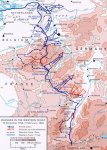
Last edited:
By 1943, a 37mm cannon was obsolete. It was, in effect, a way for an American cannon crew to let a German tank crew know that they had been spotted (e.g Clang! Heinrich: "Hey Fritz, what was that? Fritz: "It means an American AT cannon crew has spotted us.")maybe they were looking for "speed, speed, speed" (in my best ua coaches voice)! Sorry, couldn't help myself.
Last edited:
November 6, 1944: In the Scheldt, Canadian 1st Army continues clearing Walcheren Island resulting in the capture of Middleburg - they also attacking along the Maas, attacking around Moerdijk, and take over Nijmegen sector from British 2nd Army.
In the Hurtgen Forest, the Americans driven out of Schmidt (southeast of Aache) strike back with the reinforcement of tanks and mobile artillery. They repulse new German counterblows and make limited advances against the strong resistance. Air forces are now teamed with the ground troops, sending bombs on already-destroyed Schmidt in addition to strafing the Germans holding the town. Pilots claim destruction of 10 enemy armored vehicles, and estimate 12 to 15 German tanks are damaged. Northwest of Schmidt, the Americans inch ahead against Germans stubbornly determined to prevent an advance to the Roer River, one of the last barriers before Cologne. Minefields and artillery barrages slow progress. Near Germeter, infantrymen encircle one small but strongly entrenched German force. German counter-attacks retake Vossenack (in the Hurtgen Forest), although the Americans regain about half the town by nightfall - this local offensive has been definitely checked.
The Germans are well aware that the American advance through the Hurtgen Forest will put the 1st Army in an advantageous position around Duren and the entire German position along the Roer River. They fight hard and counter-attack repeatedly, having some success.
The inability to advance in the Hurtgen only doubles the resolve of the strategists, who develop a plan for a massive all-out offensive toward the Roer, including a significant effort in the forest. To maintain the striking force, Hodges orders the 12th Infantry Regiment from the 4th Division to be attached to the 28th Division and relieve the shattered 112th. As soon as possible, the 4th's 8th and 22nd regiments will take over the remainder of the 28th's positions. In addition, the 1st Infantry Division, which has finally taken Aachen, is summoned for an attack from the north. Along the left flank of the 47th Infantry Regiment, GIs are to strike toward Gressenich from their Schevenhütte outpost. To soften resistance, a massive bombing attack by the U.S. 8th Air Force and the British RAF will precede a sustained cannonade from corps and division artillery. Despite this massive bombardment, the Germans remain determined.
Over Germany, Allied air dominance continues, allowing the US 8th Air Force to attack Hamburg with 280 bombers, Mittelland canal with 204 bombers, Sterkrade with 134 bombers, Neumunster with 254 bombers, Duisburg with 65 bombers, and targets of opportunity with 64 bombers. US 15th Air Force attacks Vienna, Moosbierbaum, Kapfenberg, and other targets. RAF Bomber Command sends 738 aircraft to attack Gelsenkirchen during the day escorted by Fighter Command, followed by 48 aircraft to attack Gelsenkirchen overnight, 235 aircraft to attack the Mittelland canal, 128 aircraft to attack Koblenz, and 18 aircraft to attack Hannover. The Luftwaffe loses eight fighters in daylight operations in defense of the Reich and occupied territory against Allied strategic bombing.
On the eastern front, the 46th Army of Soviet 2nd Ukrainian Front unsuccessfully attacking across the Danube at Csepel Island.
In Italy, Allied forces continue to attack along the Gothic Line - British 8th Army attacks around Monte Chioda, Monte Pratello, and Monte Testa, while US 5th Army captures Monte Monsignano. US 12th Air Force aircraft attacks Brenner Pass and provides ground support and US 15th Air Force attacks Bolzano. US Navy destroyer Plunkett uses it’s 5” guns to pound German positions around Ventimiglia.
Pictured: A Bren gunner of the United Kingdom 8th Royal Scots at Moostdijk, Netherlands, November 6, 1944.; Medics help an injured GI in the Hurtgen Forest - casualties accounted for more than 1/4 of the 120,000 Allied (all US) troops in the battle for the forest.; US 40 mm Bofors move along a typical trail in the Hurtgen, early November, 1944.; PFC's Charles Leazuron (doing the wrenching) and rider Jack Rudeen adjusting the front brake of a Harley-Davidson WLA, somewhere in northwestern Europe, November 6, 1944.
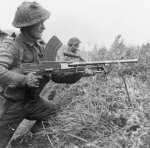
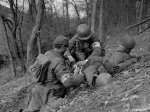
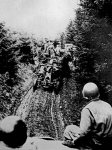
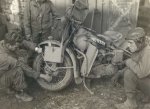
In the Hurtgen Forest, the Americans driven out of Schmidt (southeast of Aache) strike back with the reinforcement of tanks and mobile artillery. They repulse new German counterblows and make limited advances against the strong resistance. Air forces are now teamed with the ground troops, sending bombs on already-destroyed Schmidt in addition to strafing the Germans holding the town. Pilots claim destruction of 10 enemy armored vehicles, and estimate 12 to 15 German tanks are damaged. Northwest of Schmidt, the Americans inch ahead against Germans stubbornly determined to prevent an advance to the Roer River, one of the last barriers before Cologne. Minefields and artillery barrages slow progress. Near Germeter, infantrymen encircle one small but strongly entrenched German force. German counter-attacks retake Vossenack (in the Hurtgen Forest), although the Americans regain about half the town by nightfall - this local offensive has been definitely checked.
The Germans are well aware that the American advance through the Hurtgen Forest will put the 1st Army in an advantageous position around Duren and the entire German position along the Roer River. They fight hard and counter-attack repeatedly, having some success.
The inability to advance in the Hurtgen only doubles the resolve of the strategists, who develop a plan for a massive all-out offensive toward the Roer, including a significant effort in the forest. To maintain the striking force, Hodges orders the 12th Infantry Regiment from the 4th Division to be attached to the 28th Division and relieve the shattered 112th. As soon as possible, the 4th's 8th and 22nd regiments will take over the remainder of the 28th's positions. In addition, the 1st Infantry Division, which has finally taken Aachen, is summoned for an attack from the north. Along the left flank of the 47th Infantry Regiment, GIs are to strike toward Gressenich from their Schevenhütte outpost. To soften resistance, a massive bombing attack by the U.S. 8th Air Force and the British RAF will precede a sustained cannonade from corps and division artillery. Despite this massive bombardment, the Germans remain determined.
Over Germany, Allied air dominance continues, allowing the US 8th Air Force to attack Hamburg with 280 bombers, Mittelland canal with 204 bombers, Sterkrade with 134 bombers, Neumunster with 254 bombers, Duisburg with 65 bombers, and targets of opportunity with 64 bombers. US 15th Air Force attacks Vienna, Moosbierbaum, Kapfenberg, and other targets. RAF Bomber Command sends 738 aircraft to attack Gelsenkirchen during the day escorted by Fighter Command, followed by 48 aircraft to attack Gelsenkirchen overnight, 235 aircraft to attack the Mittelland canal, 128 aircraft to attack Koblenz, and 18 aircraft to attack Hannover. The Luftwaffe loses eight fighters in daylight operations in defense of the Reich and occupied territory against Allied strategic bombing.
On the eastern front, the 46th Army of Soviet 2nd Ukrainian Front unsuccessfully attacking across the Danube at Csepel Island.
In Italy, Allied forces continue to attack along the Gothic Line - British 8th Army attacks around Monte Chioda, Monte Pratello, and Monte Testa, while US 5th Army captures Monte Monsignano. US 12th Air Force aircraft attacks Brenner Pass and provides ground support and US 15th Air Force attacks Bolzano. US Navy destroyer Plunkett uses it’s 5” guns to pound German positions around Ventimiglia.
Pictured: A Bren gunner of the United Kingdom 8th Royal Scots at Moostdijk, Netherlands, November 6, 1944.; Medics help an injured GI in the Hurtgen Forest - casualties accounted for more than 1/4 of the 120,000 Allied (all US) troops in the battle for the forest.; US 40 mm Bofors move along a typical trail in the Hurtgen, early November, 1944.; PFC's Charles Leazuron (doing the wrenching) and rider Jack Rudeen adjusting the front brake of a Harley-Davidson WLA, somewhere in northwestern Europe, November 6, 1944.




I would point out that behind the Hürtgen was exactly where the stockpiling for the Bulge offensive was taking place, that being one of reasons the Germans spent so much effort and blood in defending it. I'm reminded of the expression "Fog of War"...Simply put "hit'em where they ain't."
View attachment 4808
As you can see, the distribution of German troops was far from even across the entire front.
And it was not so much a question of where to hit the Germans, but when. Let me explain.
N. B. Forrest said something in his home-spun way that is still true today: "Keep up a skeer." If you have your opponent reeling backwards (as the Allies had the Germans from 1 Aug 44 to around 10 Sep 44), it is worth the effort to keep pushing as long and as hard as you can. Napoleon defeated the Prussians at Jena-Auerstadt in October 1806 and maintained the pursuit all the way to the Baltic Sea, reducing the remaining Prussian forces to less than 10% of what they had had before Jena. Once the defender stops reeling backwards and gives evidence of resilience, the "skeer" has been lost and the offensive should probably stop and consolidate.
I would have gone defensive in the Aachen-Huertgen, slowed the overall pace of operations, stockpiled supplies, maybe cleaned up some leftover pockets elsewhere (if there were still some that could be dealt with to the Allies advantage), then shifted forces elsewhere. Once stockpiles were built up, resume the strategic offensive where the Germans could have been attacked to advantage.
Probably something like what the Allies eventually did, Operation Lumberjack, with emphasis on the right, advancing northeast along the left bank of the lower Moselle.
View attachment 4807
True. Just to the southwest of the Huertgen was the assembly area of the 6th SS Panzer Army and they were probably stockpiling ammo, fuel, etc. by early November. Of course, the Allies were unaware of that. All they knew was that there were a bunch of German divisions huddled around Aachen-Hurtgen (and a relative scarcity of German divisions just south of the Ardennes between Bitburg and Trier), all the more reason not to attack them there.I would point out that behind the Hürtgen was exactly where the stockpiling for the Bulge offensive was taking place, that being one of reasons the Germans spent so much effort and blood in defending it. I'm reminded of the expression "Fog of War"...
The map I posted was an Allied document, reflecting all-source intelligence (recon patrols capturing POWs to determine which divisions were where, aerial recon, Signals Intelligence), assessment of which units were where, and was relatively accurate (although the truth has a date-time group attached to it, and I bet the Wacht-am-Rhein armored forces were pulled out of the line for refurbishment and replacements sometime in November).
Last edited:
Also, although I'm sure most following this closely know it, Hitler was enforcing strict radio silence, prior to Wacht am Rhein. They managed it communicating via courier. He had become suspicious that his Enigma encryption had been compromised (he was correct). Some historians have speculated that he feared that some of the assassination conspirators had compromised the code, although there's no evidence of that. Without that, it's doubtful that the Ardennes offensive would have gotten off the ground...True. Just to the southwest of the Huertgen was the assembly area of the 6th SS Panzer Army and they were probably stockpiling ammo, fuel, etc. by early November. Of course, the Allies were unaware of that. All they knew was that there were a bunch of German divisions huddled around Aachen-Hurtgen (and a relative scarcity of German divisions just south of the Ardennes between Bitburg and Trier), all the more reason not to attack them there.
The map I posted was an Allied document, reflecting all-source intelligence (recon patrols capturing POWs to determine which divisions were where, aerial recon, Signals Intelligence), assessment of which units were where, and was relatively accurate (although the truth has a date-time group attached to it, and I bet the Wacht-am-Rhein armored forces were pulled out of the line for refurbishment and replacements sometime in November).
I love this image...
This British POW's name was Horace Greasley. Following capture, the men were forced to march for 10 weeks from France to Poland. The men suffered deplorable conditions and spent much time in temperatures as low as -40°, often lodged in places such as horse stables. Those who survived the march (and partial train transfer) were beaten, tortured, and starved. Greasley was once beaten so badly he lay unconscious for two days.
He was famous for escaping over 200 times to visit his girlfriend, a local Jewish girl. He kept returning due to his loyalty - every time he returned he brought extra food or other contraband to share with his fellow captives. Greasley spent 5 years as a prisoner of war, during which time he served as camp barber and worked in the marble quarries.
In 2008, his biography, "Do the Birds Still Sing in Hell?" was published. Two years after its release, he died at age 91.
In this photo he stares down Heinrich Himmler, I admire the defiance in his face. He refused to be broken. Be that guy.
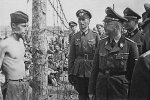
This British POW's name was Horace Greasley. Following capture, the men were forced to march for 10 weeks from France to Poland. The men suffered deplorable conditions and spent much time in temperatures as low as -40°, often lodged in places such as horse stables. Those who survived the march (and partial train transfer) were beaten, tortured, and starved. Greasley was once beaten so badly he lay unconscious for two days.
He was famous for escaping over 200 times to visit his girlfriend, a local Jewish girl. He kept returning due to his loyalty - every time he returned he brought extra food or other contraband to share with his fellow captives. Greasley spent 5 years as a prisoner of war, during which time he served as camp barber and worked in the marble quarries.
In 2008, his biography, "Do the Birds Still Sing in Hell?" was published. Two years after its release, he died at age 91.
In this photo he stares down Heinrich Himmler, I admire the defiance in his face. He refused to be broken. Be that guy.

November 7, 1944: It’s Tuesday - today marks 22 weeks (154 days) since the D-Day Invasion and the beginning of the Battle of Normandy.
In the Scheldt, the Canadian 1st Army continues clearing Walcheren Island, attacking around Moerdijk. To the south, German 19th Army counterattacks the French 1st Army around Gerardmer.
Back in the Hürtgen Forest, elements of the US 1st Army are heavily engaged around Kommerscheidt and Vossenack. A few days have passed since the so-called Allerseelenschlacht (All Souls' Day Battle, November 2) which was a disaster for the Americans. General Hodges of the First Army approves the withdrawal of all troops from beyond the Kall Bridge, but as American troops try to retreat across the bridge to Vossenack, great parts of the Kall Valley are already cut off by the Germans. A German regimental doctor (Hauptmann Guenther Stuettgen) manages to negotiate an unofficial ceasefire with the Americans at the Kall Bridge (which will last from today through November 12) in order to attend to the wounded of both sides. The lives of many American soldiers are saved by German paramedics.
Nearby, the battle in ‘Green Hell’ continues - Marcus Dillard, a mortar gunner with the 12th Infantry's Company M (still six weeks shy of his 19th birthday) who had stepped onto Utah Beach on D-Day, shared the following:
________
“We were alerted to move at once on the 6th of November. We were told to cover our division insignia on our helmets, remove or cover our shoulder patches and all markings on our vehicles. At about 1800 hours we started moving north. It was cold, miserable and raining. We arrived and started de-trucking about 0200 in the morning of the 7th.”
“It was dark and I mean dark, raining, cold, wind blowing. We all wondered, 'Where are we?' This was a secret move, and no one except the top brass knew where we were. I looked up trying to see something, and all I could make out were the tops of trees swaying and hear the wind whistling through them. We were told to move out and to follow the man in front as close as possible. We didn't want anyone to get lost. We were told to leave our 81mm mortars behind. We would take the ones left by the unit we were relieving, and they would get ours. We walked, stumbled and slipped for the next couple of hours, barely able to see where we were going. We finally halted and were to stay in place. Wet and miserable as I was, I dropped off to sleep — I don't know for how long — but then we were told we would take the foxholes and positions of the soldiers we were to replace. It was starting to get daylight, and we could see the shoulder patches of the 28th Division. They didn't say much. They just moved out and looked tired and exhausted.”
“As it got brighter, what I saw scared me. Shell holes all over, the trees, most of them looked like shredded matchsticks with points. Half of the trees standing, the bark was torn off by shrapnel. Just utter devastation. It was cold, rainy, foggy. Just plain miserable. No hot food, just K rations. Our positions must have been the only open area around because we had to have clearance overhead in order to fire our 81s. The Germans had to know our positions because of that. We could not see our targets but were told what they were.”
“The artillery fire on us was very intense. The Germans started a barrage that lasted over three hours. We had cut logs and put them over the slit trenches that had mounds of dirt around them. We could not even get out to our mortar positions, which were about 20 to 30 feet out in the clearing. The telephone line to the company CP was cut by the barrage, and we had no communication. We could not give supporting fire until we fixed the cut lines.”
________
On the eastern front, the 57th Army of Soviet 3rd Ukrainian Front crosses the Danube around Batina and Apatin. The 4th Guards Army of Soviet 3rd Ukrainian Front pushing toward Lake Velencei and Lake Balaton.
In Italy, British 8th Army begins an offensive at Forli, while US 12th Air Force aircraft provide ground support and attack transportation targets in northern Italy and attacks rail lines around the Brenner Pas.
Pictured: The Kall Trail, showing the Kommerscheidt side of the gorge in the background, November 7, 1944.; A Weasel (M29 Cargo Carrier), similar to those used for evacuating wounded, pulls jeep out of the mud during the retreat.; Situation map from November 7, 1944.
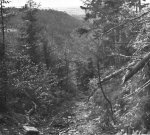
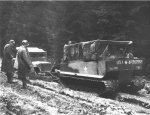
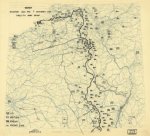
In the Scheldt, the Canadian 1st Army continues clearing Walcheren Island, attacking around Moerdijk. To the south, German 19th Army counterattacks the French 1st Army around Gerardmer.
Back in the Hürtgen Forest, elements of the US 1st Army are heavily engaged around Kommerscheidt and Vossenack. A few days have passed since the so-called Allerseelenschlacht (All Souls' Day Battle, November 2) which was a disaster for the Americans. General Hodges of the First Army approves the withdrawal of all troops from beyond the Kall Bridge, but as American troops try to retreat across the bridge to Vossenack, great parts of the Kall Valley are already cut off by the Germans. A German regimental doctor (Hauptmann Guenther Stuettgen) manages to negotiate an unofficial ceasefire with the Americans at the Kall Bridge (which will last from today through November 12) in order to attend to the wounded of both sides. The lives of many American soldiers are saved by German paramedics.
Nearby, the battle in ‘Green Hell’ continues - Marcus Dillard, a mortar gunner with the 12th Infantry's Company M (still six weeks shy of his 19th birthday) who had stepped onto Utah Beach on D-Day, shared the following:
________
“We were alerted to move at once on the 6th of November. We were told to cover our division insignia on our helmets, remove or cover our shoulder patches and all markings on our vehicles. At about 1800 hours we started moving north. It was cold, miserable and raining. We arrived and started de-trucking about 0200 in the morning of the 7th.”
“It was dark and I mean dark, raining, cold, wind blowing. We all wondered, 'Where are we?' This was a secret move, and no one except the top brass knew where we were. I looked up trying to see something, and all I could make out were the tops of trees swaying and hear the wind whistling through them. We were told to move out and to follow the man in front as close as possible. We didn't want anyone to get lost. We were told to leave our 81mm mortars behind. We would take the ones left by the unit we were relieving, and they would get ours. We walked, stumbled and slipped for the next couple of hours, barely able to see where we were going. We finally halted and were to stay in place. Wet and miserable as I was, I dropped off to sleep — I don't know for how long — but then we were told we would take the foxholes and positions of the soldiers we were to replace. It was starting to get daylight, and we could see the shoulder patches of the 28th Division. They didn't say much. They just moved out and looked tired and exhausted.”
“As it got brighter, what I saw scared me. Shell holes all over, the trees, most of them looked like shredded matchsticks with points. Half of the trees standing, the bark was torn off by shrapnel. Just utter devastation. It was cold, rainy, foggy. Just plain miserable. No hot food, just K rations. Our positions must have been the only open area around because we had to have clearance overhead in order to fire our 81s. The Germans had to know our positions because of that. We could not see our targets but were told what they were.”
“The artillery fire on us was very intense. The Germans started a barrage that lasted over three hours. We had cut logs and put them over the slit trenches that had mounds of dirt around them. We could not even get out to our mortar positions, which were about 20 to 30 feet out in the clearing. The telephone line to the company CP was cut by the barrage, and we had no communication. We could not give supporting fire until we fixed the cut lines.”
________
On the eastern front, the 57th Army of Soviet 3rd Ukrainian Front crosses the Danube around Batina and Apatin. The 4th Guards Army of Soviet 3rd Ukrainian Front pushing toward Lake Velencei and Lake Balaton.
In Italy, British 8th Army begins an offensive at Forli, while US 12th Air Force aircraft provide ground support and attack transportation targets in northern Italy and attacks rail lines around the Brenner Pas.
Pictured: The Kall Trail, showing the Kommerscheidt side of the gorge in the background, November 7, 1944.; A Weasel (M29 Cargo Carrier), similar to those used for evacuating wounded, pulls jeep out of the mud during the retreat.; Situation map from November 7, 1944.



- Status
- Not open for further replies.
Latest threads
-
-
-
SIAP there was an article that Joe K interviewed for assistant coach
- Started by mlingerfelt31
- Replies: 11
-
Final Home Midweek for Alabama Brings Samford to The Joe
- Started by Diamond Tide
- Replies: 0
-
-

